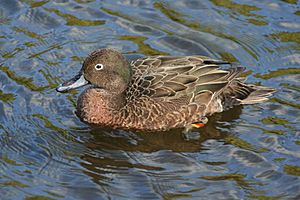Brown teal facts for kids
Quick facts for kids Brown teal |
|
|---|---|
 |
|
| Brown Teal | |
| Conservation status | |
| Scientific classification | |
| Genus: |
Anas
|
| Species: |
chlorotis
|
| Synonyms | |
|
Anas aucklandica chlorotis Elasmonetta chlorotis |
|
The brown teal (Anas chlorotis), also known as pāteke in Māori, is a special type of dabbling duck found only in New Zealand. For a long time, people thought it was the same species as the flightless Auckland teal and Campbell teal.
In the early days of European settlement, the "brown duck" was very common. People hunted it a lot for food. Its numbers quickly dropped, especially in the South Island. By 1921, these ducks became fully protected by law. Thanks to breeding programs and releasing them into safe areas, their numbers are now growing in some parts of the country.
Contents
What Does a Brown Teal Look Like?
It can be tricky to tell the difference between male, female, and young brown teals when it's not mating season. They all have a white ring around their eyes. Their heads and throats are a mottled brown color.
During the breeding season, the male brown teal changes its look. Its head becomes green, and its chest turns a chestnut color. It also gets a white stripe on each side of its body. Sometimes, males even have a white band around their neck. Some males are more colorful than others.
Brown Teal Family Tree
The pāteke is like the ancestor of the flightless Auckland teal and Campbell teal. But now, scientists agree that these are all separate species. This is because they live in different places and have differences in their feathers, size, and genes.
Scientists are careful when bringing brown teals back to new areas. They want to make sure the new groups have a good mix of genes. This helps the ducks stay healthy and strong. For example, the first captive pāteke came from Great Barrier Island. Most of these birds had only one type of gene. But in another wild group, there were eleven different types! It's important to have this variety for the species to thrive.
How Do Brown Teals Behave?
Brown teals are mostly active at night, unlike many other ducks. This is because they evolved to avoid daytime predators like the New Zealand falcon.
However, brown teals have no natural defenses against new predators that arrived with humans. These include cats, dogs, stoats, and ferrets. These animals can kill adult ducks and their ducklings. Rats also eat their eggs.
What Do Brown Teals Eat?
Brown teals find their food by dabbling or tipping their bodies upside down in the water, just like their relatives. Their diet is mainly made up of small water creatures. These include insects and their larvae, or small crustaceans. They also really like mollusks, which are animals with shells.
They eat small mollusks like pipi and large wedge shells whole. These are then crushed in their gizzard, which is a part of their stomach. For bigger cockles, like the New Zealand cockle, some brown teals have a special trick. They can force their soft bills between the cockle shells. Then, they use a quick, pumping motion to tear out the flesh. This unique way of eating hasn't been seen in other birds! At night, brown teals will also look for food on land, sometimes far from the streams where they hide during the day.
How Do Brown Teals Breed?
Brown teals build their nests from dry grass. They usually place them near water or under the cover of large plants. The nest is heavily lined with soft down feathers.
A female brown teal lays about four to eight creamy-brown eggs. Only the female sits on the eggs to keep them warm. This takes about 27 to 30 days. The male stays nearby to guard their territory. He will aggressively chase away other water birds.
Where Do Brown Teals Live and How Are They Protected?
The brown teal is an endangered species. Most of them now live on islands off the coast of New Zealand. They also live in special sanctuaries on the mainland, like Tawharanui Regional Park. These sanctuaries are protected from predators.
In the past, brown teals were found all over the New Zealand mainland. But they disappeared because of introduced predators like cats, dogs, and rats. These animals easily hunted the brown teal, which is a gentle bird that doesn't fly very strongly.
According to the IUCN, there are fewer than 1,000 adult brown teals left. Efforts are being made to protect them and help their numbers grow again.
Images for kids
See also
 In Spanish: Cerceta parda para niños
In Spanish: Cerceta parda para niños




